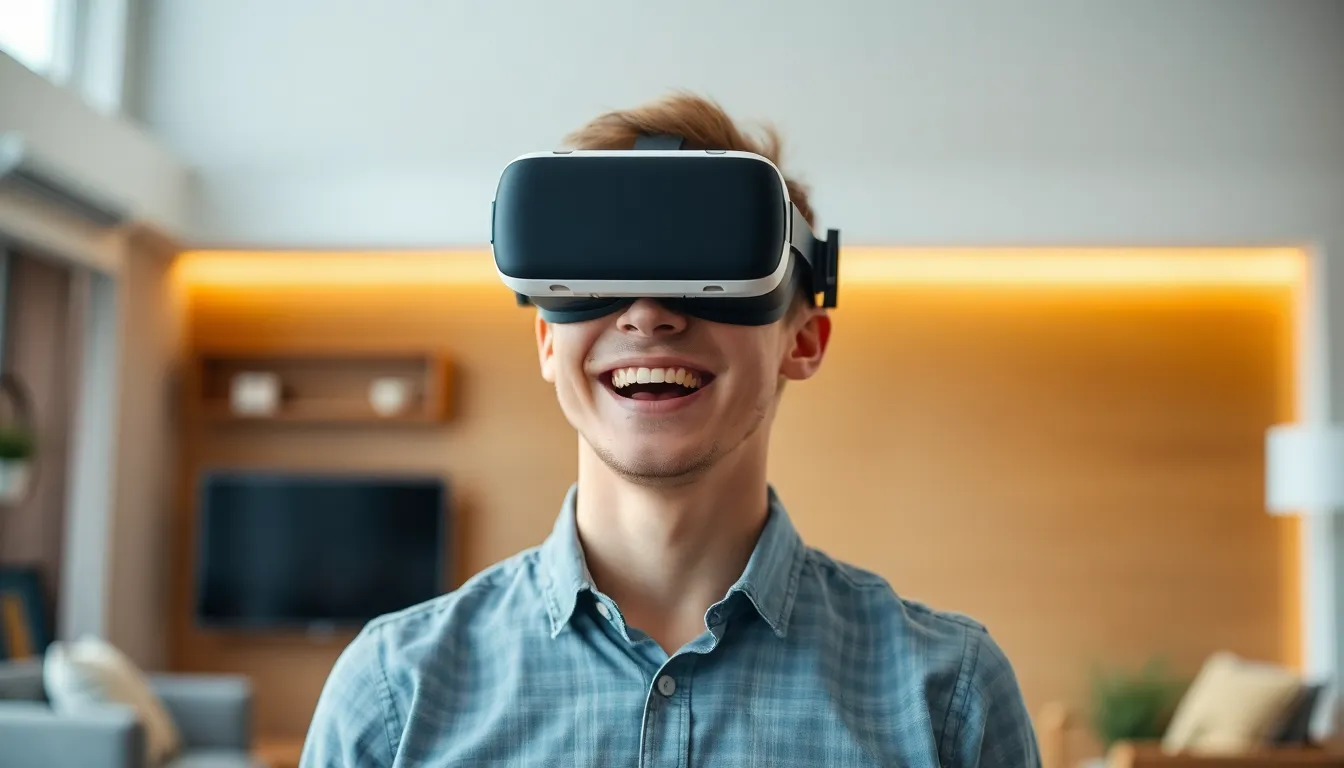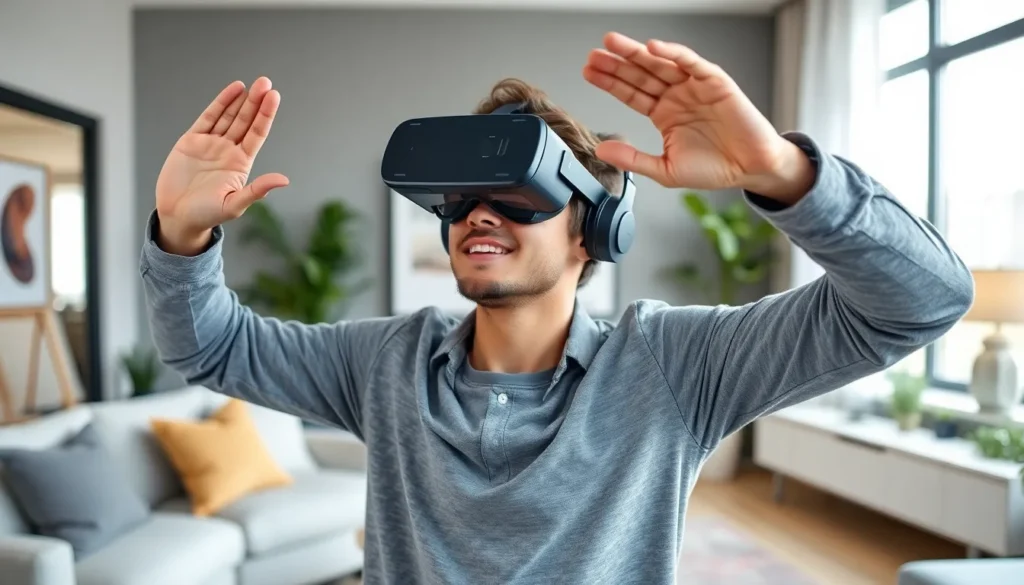In a world where reality can sometimes feel a bit too… well, real, virtual reality apps swoop in like a superhero in spandex. They transform mundane moments into thrilling adventures, whether it’s exploring distant galaxies or diving into the ocean’s depths without ever getting your feet wet. With just a headset and a sprinkle of imagination, users can escape the ordinary and dive headfirst into extraordinary experiences.
Table of Contents
ToggleOverview of Virtual Reality Apps
Virtual reality apps offer immersive experiences that captivate users. These applications utilize headsets to create environments where users can interact with 3D spaces. Users can explore uncharted territories, dive into vibrant oceans, or travel through fantastical worlds without leaving home. Everyday life blends seamlessly with digital realms, providing a unique escape from the ordinary.
Developers craft VR apps for various purposes, including gaming, education, and training. Gaming apps often simulate experiences that challenge players’ skills and reflexes. Educational applications typically provide interactive lessons, enhancing comprehension through simulated environments. Training programs focus on realistic practice scenarios, preparing users for real-life situations in a controlled setting.
Statistics reveal a growing market for VR apps, with projections estimating the industry could reach $57.55 billion by 2027. Users engage with VR apps across diverse platforms, such as Oculus Rift, HTC Vive, and PlayStation VR. These headsets accommodate diverse user preferences, catering to casual players and serious enthusiasts alike.
Content creators constantly innovate in the VR space to enhance user engagement. Storytelling in VR apps evolves through interactivity, making narratives more personal. Gamers report higher satisfaction levels due to immersive graphics and soundscapes designed to captivate attention.
Using virtual reality, businesses also explore innovative marketing strategies. Brands create immersive ads that allow potential customers to experience products interactively. This approach encourages deeper connections, enhancing brand loyalty.
Virtual reality apps represent a significant advancement in technology, offering transformative experiences for users. The combination of creativity and technology drives growth in this rapidly evolving sector.
Types of Virtual Reality Apps

Virtual reality apps encompass a wide range of types, each tailored for different user experiences. Their applications span across various fields, including entertainment, education, and health.
Gaming Applications
Gaming applications immerse players in interactive worlds where they can participate in thrilling adventures. Players use VR headsets to navigate virtual landscapes, enhancing their gaming experience significantly. Titles like Beat Saber and Half-Life: Alyx showcase cutting-edge graphics and innovative gameplay mechanics. Highly engaging, these games motivate players to explore new strategies while competing against others. The animating nature of VR gaming retains users’ attention, creating long-lasting memories filled with excitement.
Educational Applications
Educational applications utilize VR to facilitate immersive and interactive learning environments. Students explore historical sites or engage in scientific experiments without leaving their classrooms. Programs like Google Expeditions and zSpace allow learners to travel the world or dissect virtual organisms. Interactive lessons foster a deeper understanding of complex subjects, making learning more engaging and effective. Educators appreciate how VR can cater to various learning styles, ultimately enhancing knowledge retention.
Healthcare Applications
Healthcare applications use VR for training medical professionals and providing therapeutic interventions. Surgeons practice complex procedures through realistic simulations, honing their skills in a safe environment. Patients benefit from exposure therapy for conditions like PTSD using VR experiences designed to ease anxiety. Programs such as 360° video therapy guide individuals through challenging scenarios, promoting emotional resilience. Healthcare’s integration of VR technology advances treatment methods while preparing practitioners for real-life situations.
Benefits of Using Virtual Reality Apps
Using virtual reality (VR) apps offers a range of advantages across various sectors. Immersive experiences create a sense of presence, allowing users to feel as if they are actually in the environment. Enhanced engagement results from this immersion, making tasks more enjoyable and interactive.
In gaming, VR apps provide unique challenges that enhance players’ skills and reflexes. Users can experience thrilling adventures in titles like Beat Saber, which also promotes physical activity. Educational applications serve to improve understanding through experiential learning. Historical sites or complex scientific concepts become unforgettable when learners explore them in a virtual environment.
Healthcare professionals benefit significantly from VR training programs, which simulate real-life scenarios. These simulations enable practitioners to practice procedures without the risks associated with real-life training. Exposure therapy for PTSD demonstrates how VR can support therapeutic interventions, offering patients a safe space to confront fears.
Businesses increasingly rely on VR for innovative marketing strategies. Engaging users through immersive ads creates deeper emotional connections, which can lead to higher conversion rates. Consumers often prefer interactive experiences, leading brands to adopt VR tools for showcasing products.
Data from industry analysts indicate that the VR app market could reach $57.55 billion by 2027. Developers focus on creating content that captivates users, leading to higher satisfaction across platforms like Oculus Rift and PlayStation VR. The continuous evolution of VR technology promises even more benefits, as software creators optimize user experiences through innovative storytelling.
Overall, the integration of virtual reality apps into daily life is poised to transform entertainment, education, and professional training significantly. Each application type offers distinct perks, making VR an essential tool for enhancing experiences and learning.
Challenges and Limitations of Virtual Reality Apps
Developers face several challenges when creating virtual reality apps. High costs associated with technology and equipment can limit access for many users. Performance can suffer on less powerful hardware, affecting the overall experience. A lack of standardization across VR platforms creates compatibility issues, making it difficult for users to switch between devices.
Users often experience motion sickness when engaging with VR content. Symptoms may include dizziness or disorientation, which negatively impacts user enjoyment. Furthermore, the physical space required for optimal VR experiences isn’t always available, restricting users from fully immersing themselves.
Content variety also poses a challenge. While gaming and educational apps are plentiful, many other sectors lack sufficient VR applications. Developers must invest time and resources into creating diverse content to attract broader audiences.
User interface design can complicate interactions with applications. Navigating immersive environments isn’t always intuitive, leading to frustration among less tech-savvy individuals. Additionally, the learning curve for new users may discourage engagement as individuals adapt to using VR technology.
Privacy concerns also arise with VR applications. Data collection practices for personalized experiences can intrude on users’ privacy, creating hesitation in downloading these apps. As awareness grows, users increasingly demand transparency regarding how their data is used.
Despite its transformative potential, the realm of virtual reality apps encounters notable challenges. Addressing these limitations is essential to enhance user experience and encourage broader adoption across various sectors.
Future Trends in Virtual Reality Apps
Increased integration of artificial intelligence (AI) into VR apps promises to enhance user experiences. Developers are focusing on creating smarter, more adaptive environments that respond to user actions. Mixed reality (MR) applications are emerging, blending real and virtual worlds for a more immersive experience.
Users can expect advancements in hardware, including lighter, wireless headsets with improved resolutions. Companies are investing in technology that minimizes motion sickness, allowing for longer sessions without discomfort. The introduction of social VR platforms encourages users to connect with others in shared virtual spaces.
Educational institutions are adopting VR tools for remote learning, making education more accessible. Additionally, healthcare providers explore VR for innovative therapies, including pain management and rehabilitation. Gamification in various apps motivates users to engage more deeply, enhancing their overall experience.
The gaming industry continues to evolve, with an emphasis on multiplayer environments that offer dynamic interactions. Content diversification remains critical, with a focus on developing applications beyond traditional gaming and education categories. Emerging trends highlight the importance of user-generated content, empowering users to create and share unique experiences.
Companies focusing on sustainability are integrating eco-conscious themes into their VR applications, appealing to environmentally aware users. Market projections indicate that the VR industry could exceed $57.55 billion by 2027, underscoring the growing demand for engaging, immersive experiences.
Collaborations between tech companies and content creators drive innovation, leading to fresh storytelling methods. As the virtual landscape expands, VR apps are set to revolutionize entertainment and social interactions, shaping the future of user experience.
Virtual reality apps are redefining how individuals engage with their surroundings. By offering immersive experiences across gaming, education, and healthcare, these applications enhance learning and entertainment in unprecedented ways. As technology continues to evolve, users can expect even more captivating environments and innovative features.
The growing market for VR apps signals a bright future, with potential breakthroughs in user engagement and accessibility. While challenges remain, such as high costs and technical limitations, the ongoing advancements in hardware and software promise to create a more inclusive VR landscape.
As VR becomes more integrated into everyday life, its impact on personal and professional experiences will only deepen, paving the way for a more connected and interactive world.





